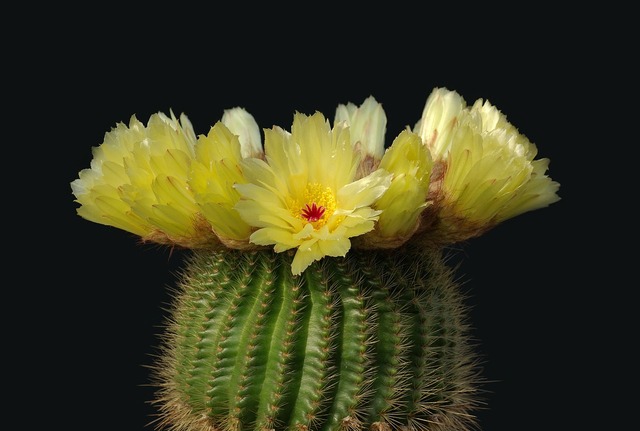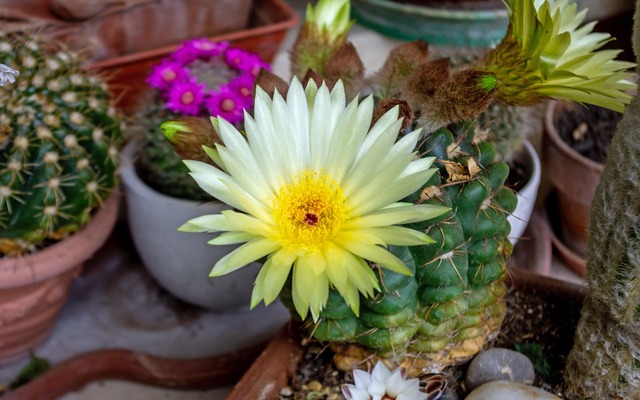Yellow and white are the most common colors for cactus flowers. We can think of at least five groups of cacti that will show a yellow bloom, and stay tuned because we’re going to cover everything that you need to know about cactuses and how to care for their yellow flowers. Flowers act as a reproductive structure for the cactus and the spines and areoles commonly give rise to the flowers on a cactus.
Cactus Species with Yellow Flowers
Keep in mind that while some of these cactus species will have yellow flowers, they may have other colors as well depending on the species. Let’s take a look at the cactus species that have yellow flowers—they include:
- California Barrel Cactus
- Golden Barrel Cactus
- Balloon Cactus
- Prickly Pear Cactus
- Mammilaria
- Matucana
- Leuchtenbergia
- Christmas Cactus

Some of the yellow flowers from these cacti will be insignificant, but you can also get some cacti that will produce some of the most stunning flowers. Many of them will have long-lasting flowers, which we will cover here, and we will also cover how to care for each of them.
California Barrel Cactus
The California barrel cactus bears a bright yellow flower toward the side that faces the sun the most. We usually see it bloom from April to June. Their color will range and you may see a yellow flower, but you could see a white, orange or red flower as well. Those colors are more rare. The yellow petals on the California barrel cactus will display a more reddish color closer to the base.
Yellow is the most common color in this cactus. The flower buds of this cactus are edible, and the Cahuilla tribe would roast the flower buds for food. Typically, you would harvest the buds during the early to midsummer. To harvest the fruits, you will need to wait from late November until March.
If you’d like to learn where it grows naturally, check out the California and Arizona deserts. The larger specimens will be located in the Mojave Desert of southern California. You might also check out the Discovery Trail in Lost Dutchman State Park.
Golden Barrel Cactus
Cactus experts classify this cactus as a slow grower and to maximize its growth, you must give it a minimum of six hours of sunlight per day. While it will grow quickly in the early stages, it starts to slow down later. From late spring to midsummer, it will produce a bright yellow flower if it receives enough sunlight and has fully matured.
You most likely won’t see the flower if you keep it indoors since this limits its sunlight. Most plant lovers, however, don’t grow the Golden barrel cactus for its flowers. Instead, they mostly want it for the foliage and the vibe that it adds to an atmosphere.
Along with the blooms being yellow, the cactus itself may become yellow, which is somewhat unusual for many cactuses. They will rarely produce a yellow flower and have a yellow body at the same time. You can find this cactus in the Sierra Madre Forests and the Mexican Drylands.
Balloon Cactus
Brilliant yellow flowers would describe the blossoms of the Balloon cactus. Along with yellow blossoms, it has pale yellow spines as well. Some have talked about the Balloon cactus as having a silky yellow-lemon flower. The flowers will appear in the spring and summer seasons. In some cases, you may see them bloom straight into autumn.
We would consider the Balloon cactus an indoor friendly cactus, and once the cactus wants to reproduce, it will flower at the top. The flowers may reach up to 2.2 inches long, and the diameter is equal to their length. You will most commonly see it blossom in the summer season.
In fact, rather than coming from North America, this cactus is native to South Brazil. Many of them don’t like direct sunlight. Eventually, this cactus will start to clump, so you will want to plant it in a container that will allow it the room to spread out.
Prickly Pear Cactus
The flowers on the prickly pear cactus will reach a diameter of 2 to 3 inches. In some cases, you will see a red center with a yellow flower. The prickly pear cactus blooms from May to July. The prickly pear cactus is a flat cactus covered in needle-like spines.
Large and bright yellow flowers come before the cactus bears reddish-pink fruit. Speaking from personal experience, it tastes delicious! Many love it for its fruit, but they fear it for its unforgiving spines. You don’t want to get pricked with this bad boy. The flowers may be yellow, but they could be red or purple as well.
The blooms on this cactus species are big and beautiful and vibrant. You can find different species of it in a variety of locations that include Texas, New Mexico, Indiana, Florida, Massachusetts, Connecticut, Rhode Island and Montana.
In some cases, they have poetically called it the “Yellow Rose of Texas Cactus,” which you can find throughout the Lone Star State. This beautiful Spanish rose has seen use in traditional Mexican cuisine, and they occasionally juice the fruit for drinks.
In case you’d like to see the life cycle of the prickly pear cactus’s flower, you can check a short video of it out here:
Mammillaria
Known in Ukraine as the Bakerburg Mammillaria, this plant has brown spines and produces a large yellow to yellow-orange flower. You may notice variations in the size and color of the flowers, depending on the cactus. Mammillaria grows in the desert regions of Central America, such as in Mexico.
The flowers appear in the spring of the year, and they have a bright yellow appearance. This is a slow-growing cactus, and it usually develops into a cluster of stems. You may want to put the cactus in a location with full sun for the best results.
The plant has excellent pest resistance and has become a favorite among cactus collectors for its beauty. Most of the flowers on this plant will be of a medium size as far as flowers compare to the others. The outside part of the flower will have a ring of petals that surround the flower itself. Usually, you will see two to three flowers on it.
You might consider this cactus similar to the Rosy Pincushion Cactus. Mammillaria flowers will usually last for about one week, and the buds that they produce will start in the previous season and go through the winter. They blossom over the summer months. To get a mammillaria to produce its flowers, you will want to add fertilizer over its growing season.
Matucana
The flowers on the Matucana will appear as either red, pink, orange or yellow. You will see the flower form on the cactus once it matures at two to three years old. I would call the flowers on the Matucana as some of the most beautiful cactus flowers. When golden yellow, they will have blood-red apices.
The one thing to remember with the Matucana is that it doesn’t flower often but watch out for once it starts. They form at night and will last for two to four days. Most often, the flowers on this cactus won’t be yellow. In most cases, the Matucana blossoms will be a red flower, but they can be yellow, pink or orange.
Usually, the Matucana will bloom in the late spring to the summer season. When we talk about Matucana flowers, we refer to 20 species of cactus that are only natively known to the regions of Peru. In fact, this cactus takes its name after the Andean city of Matucana. For the flowers to grow on this plant, they require plenty of sunlight. When the cactus doesn’t flower, it most often happens because of it being etiolated or needing more sunlight.
Given the right conditions, they can flower throughout the year.
Leuchtenbergia
The Leuchtenbergia requires four years before it starts to flower, but it most often produces pale yellow flowers shaped like a funnel up to 2.4 inches in diameter. Between the spring and fall season, it usually produces one or more yellow flowers.
Another one of the benefits of this cactus flower? The fragrance is delightful! The strong scent of it can fill a greenhouse once the sunlight starts to fall on it. Some have even described the scent as an expensive perfume.
Every once in a while, this cactus will bloom with pink highlights around the edges of the flower, but this only happens rarely. The plant itself doesn’t look particularly attractive, but once it flowers, it looks incredible. We would, however, say that this is one of your more unique-looking cactuses. It looks unlike any of the other cacti that you have ever seen.
If we had to compare it to a similar plant, we would say that it bears some resemblances to the Agave with its long and tubercle limbs. It can grow up to 70 cm tall.
The Leuchtenbergia, while it’s a German name, is native to North-Central Mexico. For example, you can find it in the regions of Chihuahua and San Luis Potosi. You do need a good amount of sunlight to see it flower. It prefers direct sunlight even though you could plant it in partial sunlight.
You could take the Leuchtenbergia to a room with full sun, leave it and it would prosper in that environment. While it does like direct sunlight, keep a close eye on it since all cacti—believe it or not—can get too much sunlight. Watch for disparate spots on the cactus and change its environment if seeing too much sun.
In case you’d like to see the Leuchtenbergia and its flowering out in the wild, check out the video here. It includes some great information as well as shows the yellow flower on it:
Christmas Cactus
The yellow flower on a Christmas cactus is known as a zygocactus, and they show you a very delicate yellow-green color. This plant was native to the jungles in South America, and it produces its yellow flowers once per year. Unlike the other cacti on this list, it doesn’t bloom in the spring, summer or fall.
In fact, this cactus produces its flowers in the winter toward the end of the year. This was probably where they came up with the name for a Christmas cactus since it produces its flowers close to Christmas. As you could imagine, a Thanksgiving cactus will bloom closer to Thanksgiving and the same goes for an Easter cactus.
This isn’t a hard rule—obviously, nature has no rules like that—and it can come in the middle of winter as well. The flowers on this cactus will usually last from six to nine days. After the plant flowers, some plant experts will pinch off parts of it to give it a more unique appearance. In the right conditions, the flowers may last for seven to eight weeks, but keep in mind that this is fairly rare.
What Does It Mean When Your Cactus Flowers?
The flowering of a cactus takes on different meanings for everyone. Some see its flowering as a symbol of endurance in hard places such as on a thorny cactus. Others would describe the meaning of this as a symbol of great love since people often pour their hearts into the daily waterings and care of it. The plant becomes their baby as they watch it grow.

What it means for each individual will differ, and there’s no right or wrong answer for this question.
What Should I Do After My Cactus Blooms?
Once the bloom has ended, you want to remove the dead blossoms as soon as possible. You do this because it can promote extra blooms on the cactus. At the same time, it encourages the growth of your cactus. In some cases, you may not need to do this since it will drop off the plant automatically, but it depends on the species. You may want to check for seeds before removing the flowers.
What Time Do Most Cacti Bloom?
Most cacti will bloom in the early hours of the morning, and some species may keep their flower open all day, depending on the sun and its intensity. In some cases, the flower starts to fade around the middle part of the day. In terms of the time of the year that they bloom, most cacti will produce their flowers in the spring and summer seasons.
How to Care for Cactuses with Yellow Flowers
To begin with, you will want to plant your cactus in soil with good drainage. Most cacti grow in the deserts, and they aren’t used to the soil holding in the water. Planting them in soil without good drainage will lead to root rot.
To ensure that your cactus has the best chance at producing yellow flowers, you will want to plant them on the southern side of the home if possible. This gives them the most sunlight.
Expert Tip: Always consider the species and how much sunlight it likes to receive to plant it in the right location.
Whenever handling cacti, you will want to put on heavy leather gloves to keep the spines from penetrating the skin. This may sound like a simple non-issue, but in cases where people didn’t spot and remove them, it led to granuloma formation and inflammation. To put it simply, they can become infected in some cases leading to further complications.
Cactus: 5 Things That Can Delay Its Blooming
Let’s say that you want to see the flowers forming on your cactus, but you worry that you made a mistake somewhere that stopped it from blooming. You have five things that can interfere with your cactus getting the yellow, red, orange, pink and white blooms on it.
#1: Maturity
Most cacti don’t bloom until they reach full maturity, which will depend on the species. Some cacti like the ones that we listed above will start to show flowers in two to five years. You do have some, however, like the Saguaro cactus, which takes between 20 to 25 years to start showing blooms on it. If you can’t wait to see a cactus bloom, then buy one that has already bloomed in the past.
This cuts out the wait time, and we would especially recommend that beginners do this since it gets them started with it to see the bloomings of their cactus.
#2: Species
Some species of cactus don’t bloom frequently. While this can seem disconcerting to the beginner, it makes it all the more special to the cactus experts. Many times when these cactuses do bloom, they produce some of the most brilliant flowers. Moon cactus will rarely produce a flower, but when they do, they produce a vibrant yellow color that stands out among the best of them. You must care for them properly to see the results of it, however.
#3: Temperatures
While cactuses prosper in the heat, they won’t flower if you keep them in the hottest environment all year-round. Even in the desert, they have a season where it isn’t as hot. Striking the balance poses a challenge because of how it can’t be too hot, and you don’t want it too cold either. They need a good balance of hot and cold to form buds on the plant.
In the winter season, you might avoid keeping the room too hot since this can become a hindrance.
#4: Sunlight
With sunlight, you usually want your cactus to have no less than four hours of sunlight and no more than 10 hours of sunlight. This ensures that you meet the required limits for exposure without the sunlight disturbing the cactus before it has the chance to flower. The sunlight helps it to produce energy for photosynthesis, which is essential to all plants.
#5: Right Amount of Water
Cactus do need some water because a lack of watering can prevent them from producing flowers. Without a steady supply of water, it won’t receive enough energy to support its budding activity. If you’ve ever watched plants before, once the water starts to go dry, the flowers will begin to wilt or droop.
Remember to keep the soil mixture correct as well because cactus require soil with good drainage to where it doesn’t hold the water in for too long. Too long, and it will leave the cactus exposed to dangers like root rot, pests and other diseases that can damage or kill your plant.
Final Thoughts
If you wanted a cactus with yellow flowers, hopefully, we highlighted some choices of species as well as how to take care of them and what could be going wrong if doesn’t flower. How much a cactus flowers will depend on the species and the color of the flower will depend on the species as well. Many cacti species will produce a yellow flower more commonly, but you have a couple where it becomes rare for them to produce yellow flowers.
In case you’d like to learn more about cacti, we’d recommend checking out the book, “Cacti and Succulents Handbook.” Everyone from the novice to the experienced gardener can learn something from this book, and it includes detailed care instructions for each species of cactus.
If you enjoyed this article and would like to learn more about cactus flowers, check out my article here on red cactus flowers.


1 thought on “Expert Guide: Cactuses with Yellow Flowers”